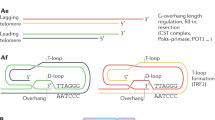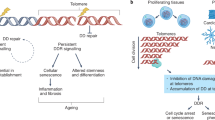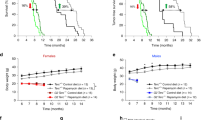Abstract
Mutational inactivation of the gene WRN causes Werner syndrome, an autosomal recessive disease characterized by premature aging, elevated genomic instability and increased cancer incidence1,2. The capacity of enforced telomerase expression to rescue premature senescence of cultured cells from individuals with Werner syndrome3 and the lack of a disease phenotype in Wrn-deficient mice with long telomeres4 implicate telomere attrition in the pathogenesis of Werner syndrome. Here, we show that the varied and complex cellular phenotypes of Werner syndrome are precipitated by exhaustion of telomere reserves in mice. In late-generation mice null with respect to both Wrn and Terc (encoding the telomerase RNA component), telomere dysfunction elicits a classical Werner-like premature aging syndrome typified by premature death, hair graying, alopecia, osteoporosis, type II diabetes and cataracts. This mouse model also showed accelerated replicative senescence and accumulation of DNA-damage foci in cultured cells, as well as increased chromosomal instability and cancer, particularly nonepithelial malignancies typical of Werner syndrome. These genetic data indicate that the delayed manifestation of the complex pleiotropic of Wrn deficiency relates to telomere shortening.
This is a preview of subscription content, access via your institution
Access options
Subscribe to this journal
Receive 12 print issues and online access
$209.00 per year
only $17.42 per issue
Buy this article
- Purchase on Springer Link
- Instant access to full article PDF
Prices may be subject to local taxes which are calculated during checkout





Similar content being viewed by others
References
Martin, G.M. & Oshima, J. Lessons from human progeroid syndromes. Nature 408, 263–266 (2000).
Hickson, I.D. RecQ helicases: caretakers of the genome. Nat. Rev. Cancer 3, 169–178 (2003).
Wyllie, F.S. et al. Telomerase prevents the accelerated cell ageing of Werner syndrome fibroblasts. Nat. Genet. 24, 16–17 (2000).
Lombard, D.B. et al. Mutations in the WRN gene in mice accelerate mortality in a p53-null background. Mol. Cell. Biol. 9, 3286–3291 (2000).
Epstein, C.J., Martin, G.M., Schultz, A. & Motulsky, A.G. Werner's syndrome: a review of its symptomatology, natural history, pathologic features, genetics and relationship to the natural aging process. Medicine 45, 5893–5897 (1966).
Goto, M., Miller, R.W., Ishikawa, Y. & Sugano, H. Excess of rare cancers in Werner syndrome (adult progeria). Cancer Epidemiol. Bio. Prev. 5, 239–246 (1996).
Yu, C.E. et al. Positional cloning of the Werner's syndrome gene. Science 272, 258–262 (1996).
Suzuki, N. et al. DNA helicase activity in Werner's syndrome gene product synthesized in a baculovirus system. Nucleic Acids Res. 25, 2973–2978 (1997).
Watt, P.M., Louis, E.J., Borts, R.H. & Hickson, I.D. Sgs1: a eukaryotic homolog of E. coli RecQ that interacts with topoisomerase II in vivo and is required for faithful chromosome segregation. Cell 81, 253–260 (1995).
Yan, H., Chen, C.Y., Kobayashi, R. & Newport, J. Replication focus-forming activity 1 and the Werner syndrome gene product. Nat. Genet. 19, 375–378 (1998).
Myung, K., Datta, A., Chen, C. & Kolodner, R.D. SGS1, the Saccharomyces cerevisiae homologue of BLM and WRN, suppresses genome instability and homeologous recombination. Nat. Genet. 27, 113–116 (2001).
Salk, D., Au, K., Hoehn, H. & Martin, G.M. Cytogenetics of Werner's syndrome cultured skin fibroblasts: variegated translocation mosaicism. Cytogenet. Cell Genet. 30, 92–107 (1981).
Melcher, R. et al. Spectral karyotyping of Werner syndrome fibroblast cultures. Cytogenet. Cell Genet. 91, 180–185 (2000).
Schulz, V.P. et al. Accelerated loss of telomeric repeats may not explain accelerated replicative decline of Werner syndrome cells. Hum. Genet. 97, 750–754 (1996).
Lebel, M. & Leder, P. A deletion within the murine Werner syndrome helicase induces sensitivity to inhibitors of topoisomerase and loss of cellular proliferative capacity. Proc. Natl. Acad. Sci. USA 95, 13097–13102 (1998).
Wong, K.K. et al. Telomere dysfunction impairs DNA repair and enhances sensitivity to ionizing radiation. Nat. Genet. 26, 85–88 (2000).
Goytisolo, F.A. et al. Short telomeres result in organismal hypersensitivity to ionizing radiation in mammals. J. Exp. Med. 192, 1625–1636 (2000).
Wong, K.K. et al. Telomere dysfunction and ATM deficiency compromises organ homeostasis and accelerates ageing. Nature 421, 643–648 (2003).
d'Adda di Fagagna, F. et al. A DNA damage checkpoint response in telomere-initiated senescence. Nature 426, 194–198 (2003).
Takai, H., Smogorzewska, A. & de Lange, T. DNA damage foci at dysfunctional telomeres. Curr. Biol. 13, 1549–1556 (2003).
Rudolph, K.L. et al. Longevity, stress response, and cancer in aging telomerase-deficient mice. Cell 96, 701–712 (1999).
Kaneko, H. et al. Expression of the BLM gene in human haematopoietic cells. Clin. Exp. Immunol. 118, 285–289 (1999).
Opresko, P.L. et al. Telomere-binding protein TRF2 binds to and stimulates the Werner and Bloom syndrome helicases. J. Biol. Chem. 277, 41110–41119 (2002).
Orren, D.K., Theodore, S. & Machwe, A. The Werner syndrome helicase/exonuclease (WRN) disrupts and degrades D-loops in vitro. Biochemistry 41, 13483–13488 (2002).
Acknowledgements
We thank P. Carpenter for the γH2AX and 53BP1 antibodies and K. K. Wong, R. Maser and members of the laboratory of S.C. for comments. S.C. is supported by a KO8 Mentored Award from the NIA and an Ellison New Scholar in Aging Award from the Ellison Medical Foundation. R.A.D. is an American Cancer Society Professor and a Steven and Michele Kirsch Investigator.
Author information
Authors and Affiliations
Corresponding authors
Ethics declarations
Competing interests
L.G. is a founder, consultant and stockholder of Elixir Pharmaceuticals.
Supplementary information
Supplementary Fig. 1
a, Hypogonadism is present in 20-week old affected G4 mTerc−/− Wrn−/− animals. Spleen (top) and testis (bottom) were isolated from mice of the indicated genotypes. Scale bar: 2 mm.b, Quantitation of testicular mass of G0 mTERC+/− Wrn+/+, G0 mTERC+/− Wrn−/−, G4-6 mTERC−/− Wrn+/+ and affected G4-6 mTerc−/− Wrn−/− mice at 20 weeks of age. (PDF 24 kb)
Supplementary Fig. 2
Non-reciprocal translocations in bone marrow metaphases derived from affected G5 mTerc−/− Wrn/− mice at 22 weeks. Arrows point to red (chromosome 10) and blue (chromosome 12) translocations. (PDF 26 kb)
Supplementary Fig. 3
Chromosomal aberrations in passage 2 G5 mTerc−/− Wrn−/− MEF. Passage 2 MEFs isolated from embryos of the indicated genotypes were subject to Giemsa staining. Small arrows: fused chromosomes, large arrows: chromosome fragments, arrowheads: interstitial chromatid breaks. (PDF 42 kb)
Supplementary Table 1
Age-related changes in early generation telomerase-Werner compound mutant mice. (XLS 16 kb)
Supplementary Table 2
Characterization of chromosomal aberrations and telomere lengths in telomerase-Werner compound mutant mice and MEFs. (XLS 17 kb)
Supplementary Table 3
Cancer incidence in telomerase-Werner compound mutant mice. (XLS 9 kb)
Rights and permissions
About this article
Cite this article
Chang, S., Multani, A., Cabrera, N. et al. Essential role of limiting telomeres in the pathogenesis of Werner syndrome. Nat Genet 36, 877–882 (2004). https://doi.org/10.1038/ng1389
Received:
Accepted:
Published:
Issue Date:
DOI: https://doi.org/10.1038/ng1389
This article is cited by
-
Senescence-related impairment of autophagy induces toxic intraneuronal amyloid-β accumulation in a mouse model of amyloid pathology
Acta Neuropathologica Communications (2023)
-
Modeling human gray hair by irradiation as a valuable tool to study aspects of tissue aging
GeroScience (2023)
-
WRN promotes bone development and growth by unwinding SHOX-G-quadruplexes via its helicase activity in Werner Syndrome
Nature Communications (2022)
-
Human WRN is an intrinsic inhibitor of progerin, abnormal splicing product of lamin A
Scientific Reports (2021)
-
Telomerase reverse transcriptase preserves neuron survival and cognition in Alzheimer’s disease models
Nature Aging (2021)



